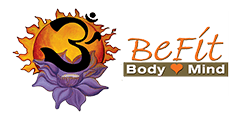Download a guide to this pose. (PDF)
Upavishta means seated, Kona means angle. It is said this posture helps balance the vayus (the five pranas) within the torso. These 5 pranas are responsible for taking in energy (in the forms of food, air, water, information, etc.), distributing it among our cells, and then removing the waste or unwanted products. Therefore it is important to maintain the integrity of the spine while in this series of poses, a rounded spine or collapsed chest will inhibit the movement and balancing of the five vayus.
Method:
- From downward dog hop through taking your legs wide, knees and toes pointing upward.
- Catch the outer edges of your feet (if you can not reach try bringing your legs a little closer together or catching your big toe instead of the outer edges of your feet). If you have tightness in your hamstrings, hips, or lower back that prevents you from reaching your feet then bend your knees to catch the outer edges of your feet.
- Inhale, lift your head and heart and extend your spine fully.
- Exhaling bend forward at your hips keeping your spine straight going as far as is steady and comfortable. Eventually you will place your forehead, chin, and then chest on the floor. Do not let your head hang forward to touch the floor, instead keep your neck in line with your spine as you work forward. Also use your bandhas to keep your pelvis from rotating anteriorly (do not flip up your tailbone!). Your pelvis should stay in neutral position while in this pose.
- Gently contract your quadriceps (front thighs) to help relax your hamstrings and protect the ligaments of the knees, make sure your legs stay neutral so your thighs, knees, or toes are not rolling inward or outward. Pay attention to not round your upper back while in the state of this asana.
- Lift and connect with mula and uddiyana bandha taking five deep breaths whilst gazing to the third eye position.
|
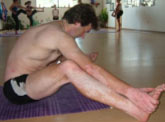 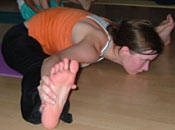 |
B position
- Inhale raise your torso while still holding on to your feet, exhale bend forward for momentum and on your next inhale try to pop your legs up and then use your bandhas, hip flexors, and arms to help pull the legs up while still holding onto your feet . . . this method may take many years to pop up into . . . in the interim, lift your torso letting go of your feet, on exhale try to raise the legs while straight and catch the outer edges of your feet. In the beginning levels bend your knees, find balance on your sitz bones holding your big toes. Keep your spine straight, this is more important than keeping your legs straight in this posture.
- Lift your heart; drop your head back while maintaining length on the back of your neck and gaze upward. If you struggle with balance here, bend your elbows a little using your biceps help to hold the position.
- Hold this position with attention to breathing and bandhas for five deep breaths.
- Exhaling ground your hands by your hips while your legs remain in the air, cross your legs, push down through your hands to pick up, tuck through, and jump back the best you can for vinyasa.
|
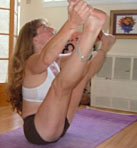 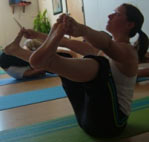 |
Benefits:
These two asana are beneficial for all back problems, including sciatica, it is important to stay connected to both mula and uddiyana bandha to get these benefits.
When the chin is on the floor in the first posture and the head is back in the second posture the esophagus is cleaned and toned.
These asanas aid in the breakdown of body fat and firming the trunk muscles-helping to keep the whole body light, healthy, and strong.




